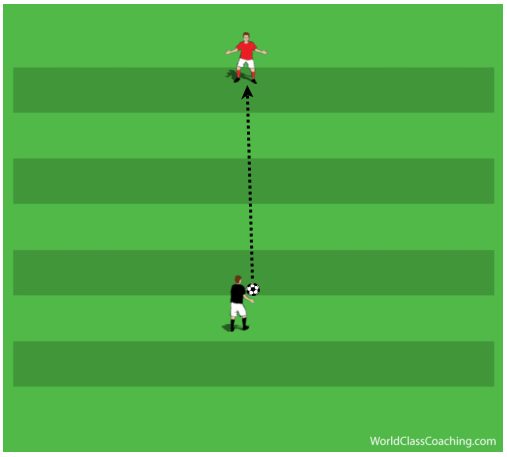- You are here:
- Home »
- Goalkeeping
Category Archives for Goalkeeping
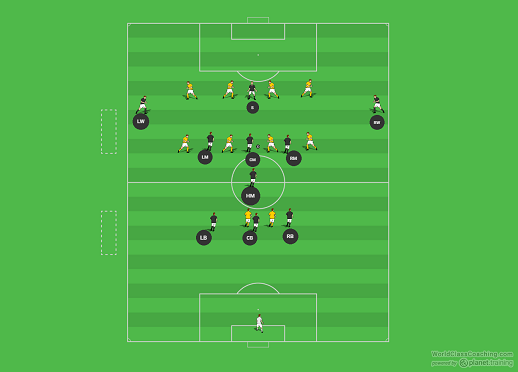
Three Option shooting drill
By Wayne Henderson –
Sometimes shooting drills can be geared towards giving the teams strikers some much needed confidence and as a result the goalkeepers are not in the thinking of the manager or coach when planning out the session. This means that the goalkeepers can feel dejected as shot after shot fly past them into the net.
This drill concentrates more on the positioning, decision making and shot-stopping aspects for the goalkeepers as well as giving the strikers different types of link up play and shooting practice.
The set up is as follows-
4 mannequins as defenders placed along the edge of the 18 yard box as shown.
The drill starts with the striker moving away from the defensive mannequin.
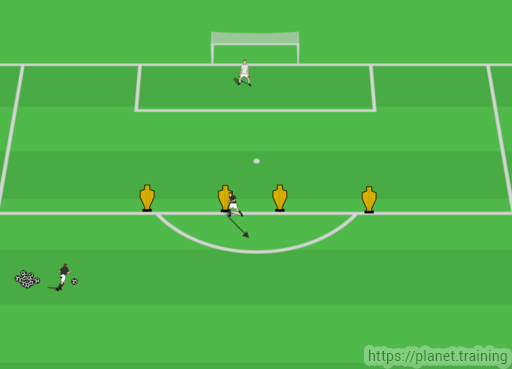
The attacking player then plays the pass to the striker, the goalkeeper then adjusts his/her position to be ready for the striker to shoot.
From this position the striker now has 3 options.
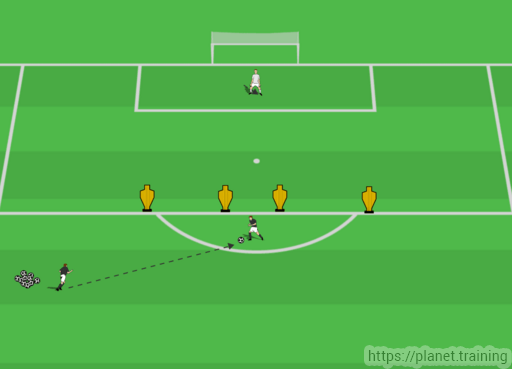
Option 1
The striker controls the pass and as quickly as possible and finds space away from the mannequins to strike a shot at goal. As shown below.
The goalkeeper must now be in a good, well balanced ready position to make a sharp save from the striker. The striker must also work on the quality of their first touch in order for them to get the shot at goal away quickly.
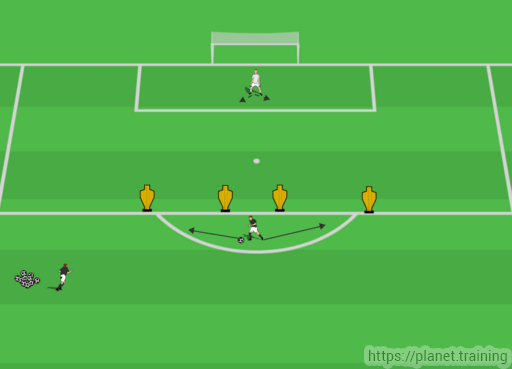
Option 2
The striker returns the pass to the attacking player who takes a first time strike at goal. Again the goalkeeper is looking to move sharply into position and be ready for the 1st time strike from the attacking player. The striker must concentrate on delivering a well weighted pass in order for the attacker to strike at goal with a 1st time shot.
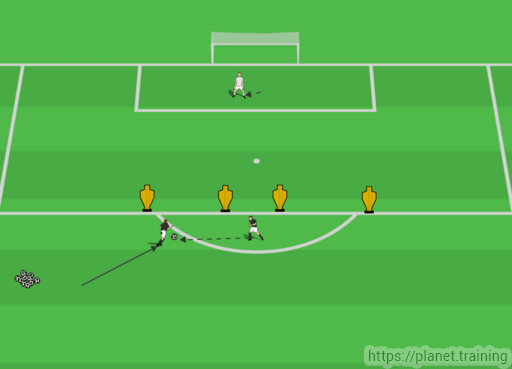
Option 3
The striker passes a ball in-between the defenders as shown below for the attacking player to move on to and strike at the goal.
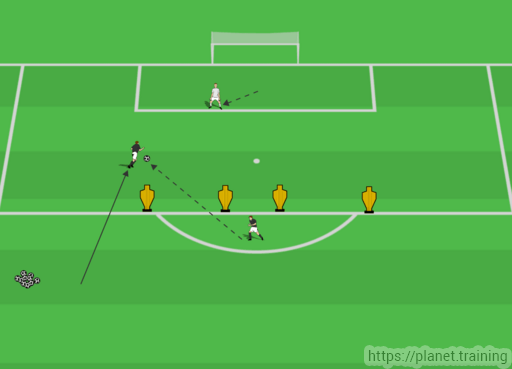
This option is the toughest to execute, because the striker must now deliver a well weighted and accurate pass for the attacking player to move on to.
This pass adds the decision making process to the drill for the goalkeeper, for example the goalkeeper has to quickly assess the weight of the pass and decide if he/she can get to the ball before the attacker.
If the goalkeeper can get to the ball before the attacker the ‘keeper comes out quickly and collects the ball, if the goalkeeper can’t get to the ball first, he/she must adopt a position that can close the angle down but still be ready and balanced to make the required save.
Especially with the 3rd option you can allow your strikers to take 1 touch to control and 1 touch to pass the ball, depending on the age and ability of your players, although the drill works best when the pass is delivered 1st time.
By Wayne Henderson
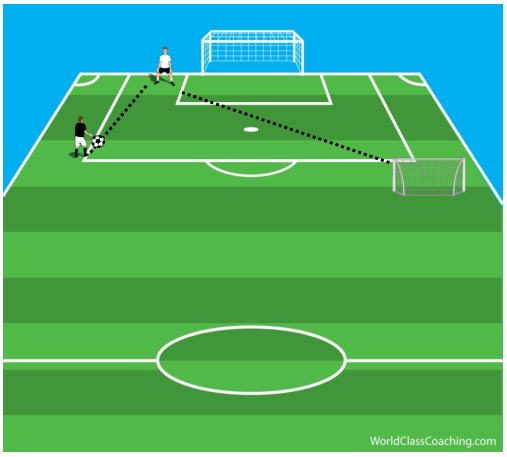
Explosive Movement across the Goal to Save
By Scott Housden –
As is the case for all other players, the goalkeeper moves considerably during games. Nevertheless, only a few of these movements undertaken serve to fulfil the defensive duties of the goalkeeper. Active movement (i.e. the goalkeeper’s movement on the pitch to ensure good positioning before attempting to make a save) across the goalmouth is key when dealing with a number of scenarios from cut-back crosses and deep crosses to second phase saves when the goalkeeper has either deflected the ball or the ball has deflected off an outfield player
These drills outlined below will allow you to work on this active movement that is an essential part of goalkeeping defensive duties.
Set Up 1
- Goalkeeper starts to the side of one of the two outside mini goals (indicated by red or blue coloured cones).
- On the servers call the goalkeeper moves with lateral using sidesteps into the first goal and gets in line with the server and gets into the ‘set’ position (sets) to make a simple save from a volley (or throw) from the server.
- The goalkeeper return the ball and continues into the next coloured goal, repeats, and then into the final coloured goal and repeats.
- Repeat drill starting from the other side.
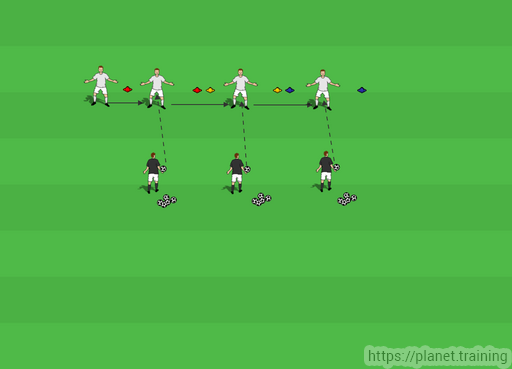
Coaching Points
As outlined above, this type of Active movement by a goalkeeper is essential in a number of scenarios during a game. Therefore, it is essential that even this basic movement is undertaken with efficiency, awareness and balance.
- Lateral movement must be level across the drill (i.e. not moving forward or backward), with the goalkeeper’s height also remaining constant when moving.
- Always look at the ball in play and have your hands in the ‘ready’ position when moving.
- Try to remain balanced and take smaller quick steps rather than larger steps (this allows the goalkeeper to remain balanced).
- Slow down as the attacker pulls back the kicking foot.
- Set in line with the server (remember ‘nose over toes’), make the save and be ready to move quickly to the next save.
Progression 1
The drill is repeated. However, this time the goalkeeper has to move more quickly across the drill. This is achieved by using crossover steps (sideways running) whilst facing the ball at all times
- The server puts in a more challenging low shot into either side of the coloured mini goal, forcing the goalkeeper to dive.
- Each time the servers must wait for the goalkeeper to set in line with the server before shooting.
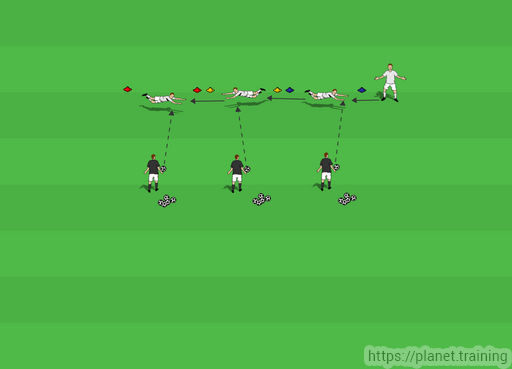
Realistically, we are simulating a larger distance across the goalmouth (i.e. post to post) with this progression and so quicker balanced movement is required by the goalkeeper.
- Crossover steps (bringing the back foot across the front foot each time) must be level across the drill (i.e. not moving forward or backward or arced), with the goalkeeper’s height also remaining constant when moving.
- This level movement across the goal is key as it is not only the most direct route across the goal but it will also allow the goalkeeper to ‘attack’ the ball when making a diving save.
- Always look at the ball in play and have your hands in the ‘ready’ position when moving.
- Try to remain balanced and take smaller quick steps rather than larger steps (this allows the goalkeeper to remain balanced).
- Slow down as the attacker pulls back the kicking foot.
- The last step before getting in line with the server will need to be a lateral step so that the goalkeeper can get into a balances ‘set’ position
- Set in line with the server (remember ‘nose over toes’), make the save and be ready to move quickly to the next save.
Progression 2
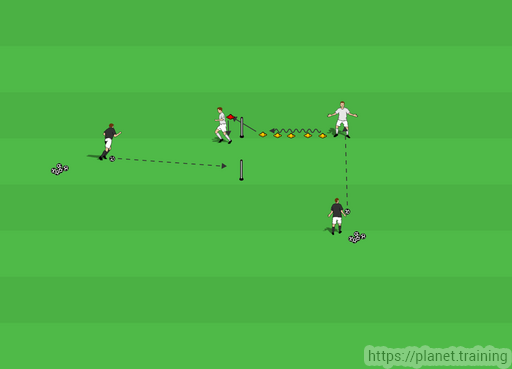
- The goalkeeper makes a simple save from the server before moving over the cones using quick crossover steps.
- The goalkeeper then quickly changes direction and moves to touch the red cone with their hand before continuing into the small goal again using crossover steps
- The server shoots low before allowing the goalkeeper to ‘set’, aiming for the far post.
- The goalkeeper must adjust their steps so they are able to make a diving save (pushing off their front foot into the dive).
- Remember to perform the drill on both sides.
Coaching Points
- Quick balanced crossover footwork across the cones with a quick change of direction to the red cone.
- Take shorter faster steps towards the red cone as well so as to remain balanced and ready to change direction again at the cone.
- After touching the cone, focus on the ball and take initial crossover steps to cover the distance quickly again levelling off across the goal with your height remaining constant.
- Adjust you steps just prior to the shot so you are able to push and drive off your front foot and attack the ball in your dive.
Progression 3
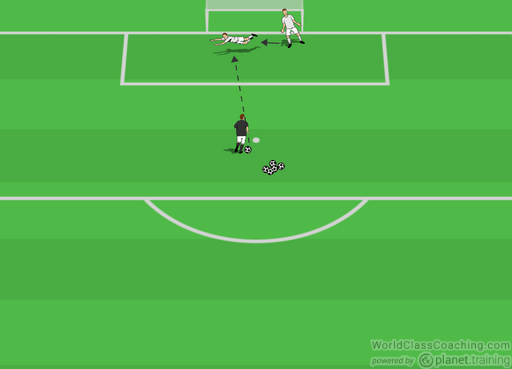
This final progression simulates a cut-back cross scenario where the ball has been cut back to an attacker on the penalty spot. Therefore quick levelled off crossover movement across the goalmouth is essential.
- The goalkeeper starts the drill close to the near post in preparation for what would be a cut-back cross.
- The goalkeeper then commences the drill by calling ‘Away’ (as they are not able to collect this pretend cut-back cross).
- They then make quick levelled off crossover movement across the goalmouth to get in line with the attacker.
- The attacker aims their shot for the far post as soon as the goalkeeper is in line with them (not allowing the goalkeeper to set).
By Scott Housden
Scott is both a UEFA ‘B’ and UEFA ‘B’ Goalkeeping Coach and holds a Masters in Sports Management. He has been a goalkeeper coach in professional football in the UK and Australia at First Team, Academy and Women’s levels. He currently runs a Goalkeeper Academy in the Western Suburbs of Brisbane, Australia.
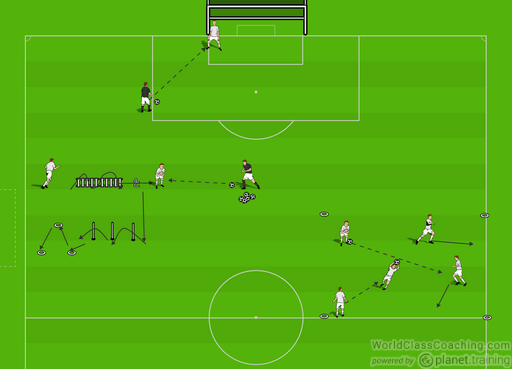
Tournament Goal Keeping
This is one of the articles and training sessions on goalkeeping and other topics that will be published this month in the Training Center. Click Here to learn how you can receive access to all of them.
By Josh Jones-Keen –
With summer here small sided tournaments are also here and with them they bring their own challenge for outfield players but also for those in goal.
The smaller and sometimes wider goals mean Keepers have to adjust their positioning more than if they were in a full size goal as shots are often hit at tight angles or cut back for a striker whose facing goal. Often the area is much smaller and Keepers might not be able to leave it, which brings its own problems! Distribution is also another challenge. Here is some prep that coaches and Keepers can work on for small tournaments.
Firstly read the rules! I was at a tournament the other day and there were a number of penalties for encroachment from a defender or for the Keeper leaving the box!
Shot Stopping
Most tournament goals are short and wide (not as wide as a full size but in comparison to the height they’re wide this means shots should be low and hard. Any shots higher should be a comfortable save for the Keeper getting across their goal with good footwork, quick short sidesteps. For diving saves:
Coaching Points
- Again good footwork is needed to get in to position
- Dive forwards to the ball, diving square or backwards could allow the ball to go for a corner or worse a goal if a mistake happens
- Body shape through the air and when landed should look like it would if catching a ball in to the chest area when standing
As well as dealing with shots a good way to practice footwork is with cone and ladder work. Once footwork is good you can add the shot stopping element to it.
Positioning
Like a regular game the Keeper should get down the line of the ball when the striker is preparing to shoot. The difficulty comes when with knowing how far to come off their line. This now depends on the size of the area.
Distribution
It’s important that the outfield work for the Keeper here. It’s tough if you’re looking at a field with no space and no movement. As a rule at least one defender should be free. Often there is a no kicking rule and sometimes a no over head throwing rule so we will look at rolling first.
Coaching Points
- Hold ball between palm and forearm with bent wrist
- Step forwards with the opposite foot, get low and bowl the ball along the floor
- Finger tips brush against the floor to ensure the ball doesn’t bobble/bounce
This can be practised one on one or if you have a group of Keepers I like to use it as a warm up in a 20 x 20 square. Coach shouts a type of distribution and the players perform the technique and move around the box. It’s also a great place to practice footwork.

By Josh Jones-Keen – Josh has been coaching Goalkeepers for over a decade & has both Outfield and Goalkeeper coaching awards from England and Scotland. He’s coached at a number of levels from grassroots to semipro and currently coaches non league Women’s team as well as a local academy.
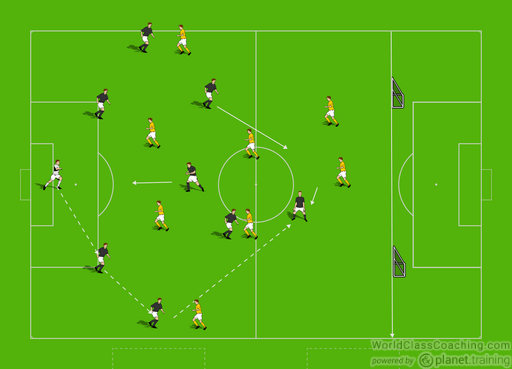
Playing Out of the Back
By Josh Jones-Keen –
Once a Keeper has the fundamentals of distribution it’s time to move on to how you would like them to play as part of the team’s tactics. This phase of play session looks at the Keeper starting play from the back.

Deciding how to play has a lot to do with the starting positions of the outfield players. If the players are not playing how the Keeper needs they must tell them. If starting position is as above the movement needs to be good, the defensive midfielder can drop but not too quickly. One centre midfielder can push to support the attackers.
[wpsharely id=”821″][/wpsharely]Coaching Points
- The Keeper must decide to either play to feet or in space
- Does the player have enough space around them to play in to space
- If so is the ball in front of them to run on to & can they control on their back foot?
- Ability to find players with the correct technique
- Rolling, clean along the ground
- Over arm, bouncing in the right place and height
- Picking the right person depending on the shape, is the defensive midfielder a good place to pass to if there is limited or no support?
Progression
Numbers can be added to fill the space more; this will work on the Keepers accuracy and decision making.
This then will progress in to a full size pitch. In an ideal world the team you are trying to coach will have 1 more player then the defending team. This allows for higher success. On the full pitch set up as near to an 11 vs 11 tactics as possible. The aim is for the team to replicate the movement and build up as they did on the smaller pitch.
By Josh Jones-Keen – Josh has been coaching Goalkeepers for over a decade & has both Outfield and Goalkeeper coaching awards from England and Scotland. He’s coached at a number of levels from grassroots to semipro and currently coaches non league Women’s team as well as a local academy.
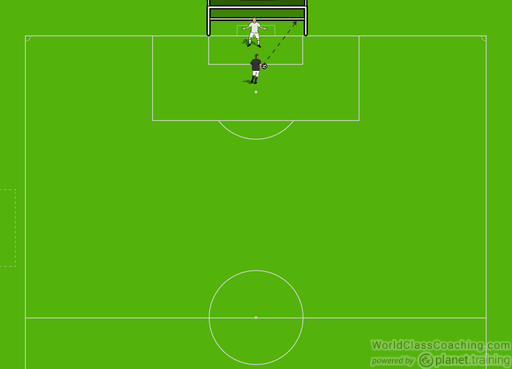
The Art of Saving a Penalty
By Josh Jones-Keen –
Often teams practice penalties but the focus is always on trying to score them. Outfield players can practice penalties to the hilt but nothing can replicate the pressure of doing it in a real game.

As for the Keeper there is no pressure. Not in training and not in a game. If you’ve got to penalties your Keeper has already done their job of not conceding in actual time. Now is the time to do the right thing and hope you get some luck on the way. This is the mentality that must be coached for majority of Keepers. Keep the pressure off so they don’t freeze.
The first drill works on the Keepers saving technique. The coach starts by pointing to a corner and then tossing the ball to that corner. This can progress to the coach drop volleying to add more power and precision to the ball. To then progress the coach could point to one corner and play the ball in the other corner. Can the Keeper keep calm and remember it’s going the other way, and then the Coach should play the ball either side without pointing. Can the Keeper now judge the body shape of striker and work out the right way?
Distance is the key here; I often start 8/10 yards away and make it harder and faster the closer to the goal, to within 5 yards. Then start working back out to I’m striking them on the drop volley around the penalty spot.
[wpsharely id=”821″][/wpsharely]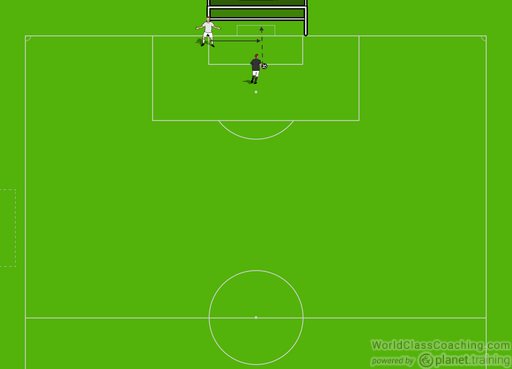
Here the Keeper starts on the other side of the Goal and the Coach strikes the ball in to the centre of the goal. The Keeper must dive across the goal to make the save. The main key point here is the dive.
To get the perfect takeoff the Keeper must propel them with the correct leg. With the Keeper facing the striker their inside leg facing towards goal must be used to push off. If the outside leg is used this is what creates Keepers rotating. In a game this is bad news as it means they cannot react to the next shot but in this case it could cost precious fractions of seconds which could be the difference to winning and losing.
Coaching Points
- Watch and judge the run up, you can tell a lot about where the ball is going based on the strikers run
- Make your decision as late as possible. React quickly.
- Dive well; know how quick you can cover ground. Push off with the inside leg
- Go two handed, move them quickly if needed
- Use the momentum of your arms pushing through to push the ball wide
By Josh Jones-Keen – Josh has been coaching Goalkeepers for over a decade & has both Outfield and Goalkeeper coaching awards from England and Scotland. He’s coached at a number of levels from grassroots to semipro and currently coaches non league Women’s team as well as a local academy.
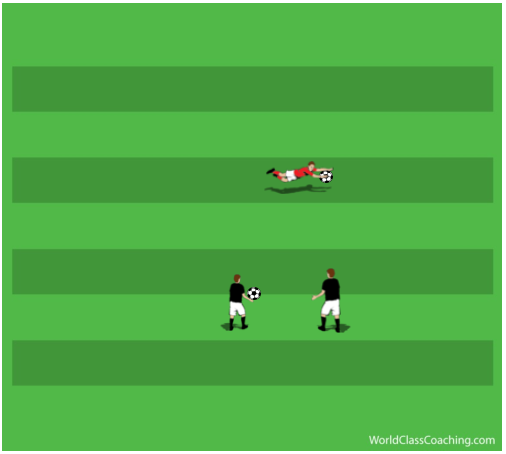
How to Speed Up Training
Welcome to the Goalkeeping Newsletter. Todays’ topic shows a simple way to speed up training.
This is going to seem incredibly simplistic but it’s something a lot of keeper coaches miss. If you want the keeper to work faster in training, add a second server and a second ball. The reason this works is the keeper is no longer in charge of how quickly a ball can be played in.
As an example, in the diagram below, the server volleys a ball to the keeper who must catch the ball and then quickly return the ball for the next serve.
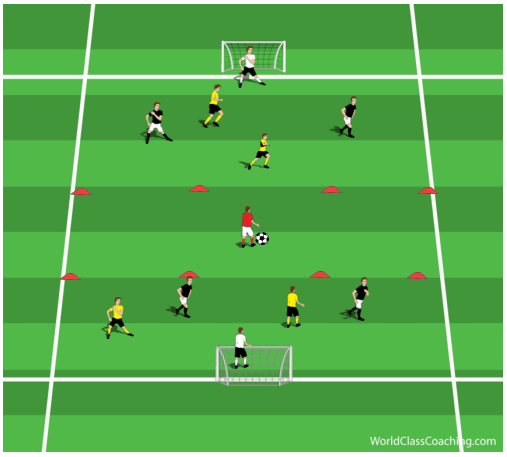
Why is David De Gea so Good?
By Josh Jones-Keen –
David De Gea has just won Man United’s player of the year for the 3rd time in a row. This is a great achievement and one that might not be beaten for some time. Some will say this is indicative of how poor Man Utd are currently however let’s put this in perspective, whilst far from their recent best they are still chasing a champions league spot and have the chance to win the FA Cup for the first time in over 10 years. A lot of what has been good about Man Utd this season has come from the back so let’s look at what makes De Gea so good and how can try to emulate him.
Communication
When De Gea first started playing for United he looked a bit lost and out of sorts as did his back line even though it was one made up of great experience. Now whilst the defenders are not anywhere nearly as good as previous incumbents De Gea has got them listening to him and they are ready to be commanded. This drill will help start to get the Keeper talking. Effective communicating can add so much to a team.
Make sure when communicating orders are brief and to the point, direct and have clear ownership. For example how many times do you hear players ‘Back if you need/want’, I tell me Keepers to be positive and if they want the ball to demand it not suggest.
These instructions cover every drill a Keeper does including playing time come match day. Here are some to use and some to avoid:
- Keeper – When call this the Keeper is staking a claim to come and get that ball. Defenders know to get out the way and attackers know what’s coming. A keeper should be saying this when comfortable to let a shot come through to them and especially when claiming a cross.
- Mark (Avoid) also ‘Mark Up’, get your Keeper in to the habit of telling defenders who to mark ‘Jill number 10’
- 18yrds – Use this instead of the traditional ‘Step Up’ or ‘Get Out’ here players know exactly where to go
- Away – Tells players to just clear the ball. It’s not the best but equivalent of ‘if in doubt clear out’
Dealing with Crosses
Again when first coming to England De Gea had looked like he almost had never caught a crossed ball in his life, now he plucks them out of the air with ease.
Coaching Points
- Receiving high balls in the W formation
- Positioning, are they in a good place to get under the ball
- Footwork, are they moving around defenders to claim the ball
- Communication, ‘Away’ or ‘Keepers’
- Body Shape, is it correct when receiving the ball and is it ready to start a counter attack
Set Up
- 50Yrds by 35yrds
- 6 on 6 but 2v2 in each sq, to start with each player is restricted to their squares
- Attackers must get the ball wide to score from a cross
- Goal Keepers try to intercept and start counter attack

Shot Stopping
Shot stopping is what really brings De Gea the plaudits. Time and time again he will pull off a save that adds to United’s points total. They would be a lot worse off without him. If saves were celebrated like goals DDG would be an even more busy man.
Set Up
The field is 50 yards long, split in to 3 zones. One end zone is 18 yards deep while the other end zone is 25 yards deep. The different size end zone will encourage different types of shots.
Coaching Points
- On top of saving the ball in the correct way Keepers should look for
- Good positioning – before and after the shot
- Good body shape – before and after the shot
By Josh Jones-Keen – Josh has been coaching Goalkeepers for over a decade & has both Outfield and Goalkeeper coaching awards from England and Scotland. He’s coached at a number of levels from grassroots to semipro and currently coaches non league Women’s team as well as a local academy.

Shot Stopping Game
By Josh Jones-Keen –
This is a fun but competitive drill recently seen performed by Burnley FC. The aim of this game is to keep the ball out of the net by any means possible. After all that’s what we’re paid to do.
This can be done 1 on 1 or with multiple Keepers by rotating more frequently. If 1 on 1 I would go best out of 10 (or whatever time permits). I would use this drill at the end of a tough session to add some light relief and not to take things too seriously as opposed to Small Sided games with the rest of the squad. These types of drills also help increase camaraderie between Keepers as a team.

[wpsharely id=”821″][/wpsharely]
Firstly the Keeper must jump over the hurdle and the striker will shout which cone (number them 1-4) the Keeper must touch the cone and reset back to the middle before the striker 1) Drop Volley, 2) Roll on the ground and strike 3) Dead Ball Strike all from the edge of the area.
As mentioned before the Keeper needs to keep the ball out of the net but praise good technique.
Progression
The Keeper starts the same and the striker still calls the cone however this time they are on the edge of the D, when the Keeper returns to the set position the Striker can roll the ball and must strike it before the 18 yard box.
By Josh Jones-Keen – Josh has been coaching Goalkeepers for over a decade & has both Outfield and Goalkeeper coaching awards from England and Scotland. He’s coached at a number of levels from grassroots to semipro and currently coaches non league Women’s team as well as a local academy.

